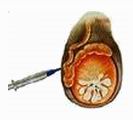Sperm Aspiration is a procedure used to obtain viable sperm from a testicle. The sperm that are collected are intended to be used with ICSI (Intracytoplasmic Insemination) because there are usually not enough sperm retrieved to perform intrauterine insemination. Sperm Aspiration is useful where there are extremely few or no sperm found in the ejaculate (azoospermia).
There are 2 main reasons why sperm may be absent from the semen:
Obstructive azoospermia is a condition in which there is a blockage in the male reproductive tract. There is normal sperm production in the testicle but the sperm cells are trapped within the epididymis.
Non-obstructive azoospermia is a condition in which there is severely deficient or absent sperm production.
TESA stands for testicular sperm aspiration. A needle biopsy of the testicle is done as an office procedure using local anesthesia. A small incision is made in the scrotal skin and then a spring loaded needle is gently inserted into the testicle. The amount of tissue obtained is low because the thin needle removes only a thin sliver to tissue.

TESA, or testicular sperm aspiration (also known as TESE, or testicular sperm extraction) is one of the surgical sperm harvesting techniques used for retrieving sperm in patients with azoospermia. A number of surgical sperm retrieval or recovery methods have been devised to recover sperm from the male reproductive tract.
In men with obstructive azoospermia, (because of duct blockage or absence of the vas deferens), sperm are usually recovered from the epididymis. The original technique was devised by a urologist, Dr Sherman Silber, who is a specialist in microsurgery. He used a method called MESA, or microepididymal sperm aspiration, in which the scrotum was opened, and an operating microscope used to identify the epididymal tubules which were distended with sperm. While this method was very successful, it was very complex, since it needed an operating microscope; and therefore very expensive as well. This is why a gynecologist from Dubai, Dr Pankaj Srivastav, developed a very simple and easy method to recover sperm from the blocked epidiymis. Since he could feel the turgid epididymis, swollen with sperm, he would blindly puncture the epididymis using a simple butterfly needle - a technique which was very similar to drawing blood from a blood vessel. This simple technique is called PESA (percutaneous epididymal sperm aspiration), in which the sperm is sucked out from the epididymis by puncturing it with a fine needle.
This method is as effective as microsurgery to retrieve epididymal sperm; is much easier for both the patientalt and the doctor; and much cheaper as well, since the infertility specialist can do it himself. It is also much less traumatic, since there is no need to cut the scrotum, with the result that there is no scar. This is why this is the preferred method of choice in most centers in India, UK and Belgium.
For patients with obstructive azoopsermia in whom sperm cannot be found in the epididymis, it is always possible to find sperm in the testis. The easiest way to retrieve this is through TESA or testicular sperm aspiration, in which the testicular tissue is sucked out through a fine needle, under local anaesthesia. The testicular tissue is placed in culture media and sent to the lab, where it is processed. The sperm are liberated from within the seminiferous tubules (where they are produced) and are then dissected free from the surrounding testicular tissue.
Using sperm from the epididymis and testis for ICSI in order to treat patients with obstructive azoospermia is logical, and thus conceptually easy to understand. However, surprisingly, it is possible to find sperm even in patients who have testicular failure ( nonobstructive azoospermia) - even in those men with very small testes. The reason for this is that defects in sperm production are "patchy"- they do not affect the entire testis uniformly
Various methods have been devised to recover sperm from the testes, and a fashionable method prevalent in the US today was developed by Dr Schlegel from Cornell, in which he uses an operating microscope to try to identify healthy testicular tissue, in the hope that the chance of finding testicular sperm improves. However, a much easier, kinder and simpler method has been developed where multiple needle biopsies are taken from both testes. While this is "blind", since it's possible to sample many more areas of the testes ( we routinely perform over 10 microbiopsies using this technique, even from very tiny testes) this technique is at least as effective as Dr Schlegel's in recovering testicular sperm. Moreover, it's much less traumatic, since no blood vessels are touched, with the result that it causes much less pain; and it can easily be repeated in a few months if needed, because the testes are not damaged.
- In vitro fertilization (IVF)
- Percutaneous Epididymal Sperm Aspiration (PESA)
- Laser Assisted Hatching …etc
- Jinemed Hospital
- Women's Health & Fertility Centre Pte Ltd
- Jindal Heart Institute & Test Tube Baby Centre
- Apollo Fertility and IVF Center
- Bangkok IVF Center
- Lilavati Assisted Conception Unit
Thailand, Malaysia, Singapore, Turkey and India are the most cost effective locations that offer up to almost 80% savings in comparison to the US.
SurgeryPlanet facilitates a plethora of services to the medical treatment traveler also which includes, a hassle free and discounted travel option, a welcome hand at the airport on arrival, travel in an air-conditioned car, round the clock service & support. Your medical evaluation is pre arranged with the least of waiting time. Once your assessment is complete and found medically fit, the procedure is immediately scheduled without a waiting period. Please read through our Services and Testimonials to understand and select your best options.
Major Treatments Abroad: Obesity / Bariatric Surgery | Spine Surgery | Stem Cell therapy | Fertility treatment | Knee replacement in India and Thailand | Heart Surgery | Organ transplant | Ayurveda Treatment | Heart valve replacement | Hip resurfacing | Hospitals in India and Thailand for Laparoscopic Sterilization| Best hospitals in Asia | JCI & ISO certified Hospitals | Cost effective medical procedures | Healthcare tourism | Complete privacy for affordable cost | Weight loss procedures | Infertility treatment | Board certified physicians | Low cost surgeries
SurgeryPlanet is an Healthcare Facilitator and not a Medical service provider. The information provided in this website is not to be used for diagnosis or treatment of any medical condition or use for any medical purposes. We provide information solely for medical travel facilitation and do not endorse any particular health care provider, hospital, facility, destination or any healthcare service or treatment listed. We are not an agent for, or affiliated to any health care provider, or service listed in our website and is not responsible for health care services provided by them. Choice of hospital or doctor for your healthcare services is your independent decision. Consult your domestic licensed health care provider before seeking the services of any health care provider you learn about from our website.


